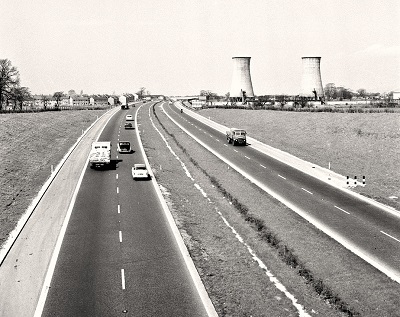 Sixty years ago today, British drivers entered a golden age of high-speed congestion-free motoring with the opening of the country’s first ever stretch of ‘motorway’.
Sixty years ago today, British drivers entered a golden age of high-speed congestion-free motoring with the opening of the country’s first ever stretch of ‘motorway’.
Although initially called the Preston Bypass, the eight-and-a-quarter mile stretch of highway was conceived from the very beginning as a ‘motor way’ – a fast multi-lane route avoiding built-up areas and the traffic congestion they inevitably brought. It proved an instant success and ignited a frenzy of motorway building projects across the UK over the following decades.
 Officially opened on Friday December 5th, 1958, the new road ran Bamber Bridge, at the southern extremity of Preston, to Broughton, at its northern tip. It would later be absorbed into the M6, the UK’s longest non-stop motorway, running from the Catthorpe Interchange, near Rugby, north to the Gretna junction, just short of the border with Scotland.
Officially opened on Friday December 5th, 1958, the new road ran Bamber Bridge, at the southern extremity of Preston, to Broughton, at its northern tip. It would later be absorbed into the M6, the UK’s longest non-stop motorway, running from the Catthorpe Interchange, near Rugby, north to the Gretna junction, just short of the border with Scotland.
It wasn’t the Government which conceived, built and promoted the Preston Bypass, but chartered civil engineer James Drake, employed as County Surveyor and Bridgemaster of Lancashire County Council from 1945 to 1972. His visionary approach to road building stemmed from a realisation as early as the 1940s that traffic levels on Britain’s road were set to snowball as road haulage overtook rail and canals, and mass production of cars made them affordable to many more people.
Drake’s first plans for the Preston Bypass, and later extensions to it, were published in his 1949 Road Plan for Lancashire. It was a comprehensive document which formed the basis of the county’s development plan for the next three decades and became the foundation of national highway planning procedures.
In the years of austerity following the Second World War there was only limited funding available for major public works, but by 1956 work on the Preston Bypass had begun. It also pioneered a new way of getting public works carried out efficiently, with separate contracts awarded to specialist firms for separate parts of the job, such as laying the Tarmac or building bridges.
Under Drake’s supervision, the county council took on the scheme as agent for the Ministry of Transport, but Drake still struggled to fully convince his London paymasters of his vision for ‘motorways’ of the future. He wanted to build the new road with three lanes running in each direction, but the Ministry said this was not justified and refused the extra cash.
Undeterred and convinced he was right, Drake built the bypass with two lanes as specified, but with an extra wide central reservation. It was big enough to accommodate an extra lane north and south when it became necessary, as Drake knew it inevitably would. This also meant the road’s two multi-span steel bridges did not need any modification when the road widening work became necessary just eight years later, in 1966. The farsighted Mr Drake had ‘futureproofed’ his bypass.
Other innovations included an emergency zone at the edge of the highways where vehicles could park safely if they broke down. Although not originally paved, this extra emergency lane was hardened with gravel, giving its name of the ‘hard shoulder’.
A hedge was also planted along the length of the central reservation to help eliminate dazzle from the headlights of oncoming vehicles at night. It was later realised that something more substantial than a hedge was needed to prevent out-of-control vehicles from crossing into the opposite carriageway.
The Preston Bypass was officially opened by Prime Minister Harold Macmillan and at that time had the largest road signs in Europe. It also had no upper speed limit, but this was soon changed when it became evident that some users – especially young men on powerful motorbikes – were travelling from far and wide to put their machines to the ultimate speed test!
Even as the Preston Bypass was being opened, construction was under way on Drake’s next big project, the Lancaster Bypass, and numerous other schemes were at various stages in the planning process. He is rightly recognised as Britain’s motorway pioneer, awarded the CBE in 1962 and knighted in 1973.
On December 5th, 2008, his daughters took part in the ceremonial unveiling of a stone plaque commemorating Drake’s work. It stands close to the spot where Prime Minister Macmillan opened Britain’s first stretch of motorway 50 years earlier.
